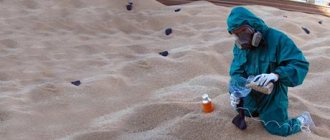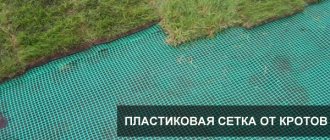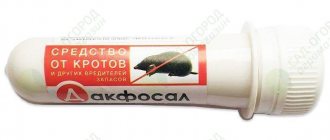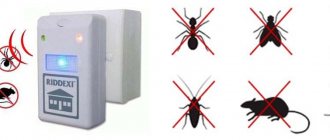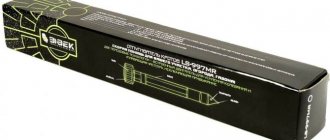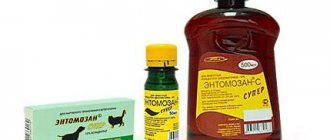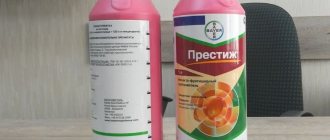Anti-mole netting to protect areas and lawns
Moles are destroying your property, but you are not ready to exterminate them using inhumane traps? The only way out is a mole net. The device is very simple, does not require special installation skills, and lasts for many years. But in order for the “barrier” to protect, you need to know some features and we will understand them.
Total protection against moles – how does it work?
The anti-mole net is a solid fabric made of durable polymer or metal with small cells of different diameters. The smaller the “clearance”, the more effectively your area will be protected from annoying shrews and other pests. The principle of operation of the design is that the mesh is laid at a shallow depth (approximately 5-10 cm) and completely blocks the animal, which seeks to dig a passage onto the surface of the lawn and throw out the soil.
When faced with a barrier, the mole is forced to turn to the side and begin to dig through the tunnel again. If the mesh is dug in throughout the entire area, the shrew will have to go deep into the ground, looking for a way out, or simply leave the area. At first glance, it is not difficult to protect your site, but there are nuances that must be taken into account when laying a grid.
Why is a mole dangerous on the site?
Although these animals are small and feed on insects, they are dangerous for the crops grown on the site. Moles dig tunnels at a shallow depth underground, in which the food they need accumulates - earthworms, wood lice, slugs, larvae, etc., even snakes and frogs. Underground animals do not compete with humans in the food chain; they do not feed on plant crops, however:
- by making tunnels, they mercilessly destroy the root systems of plants, causing significant damage to the future harvest;
- Through dug holes, earth mice and rats enter the area and feed on the grown crops.
Moles mercilessly destroy the root systems of plants.
You can understand that there are moles in the area by looking at the loose mounds of soil that the animals throw to the surface when creating burrows.
Choosing a mole net
If you are determined to completely protect your area using both vertical and horizontal installations, choose your mesh carefully. The work will be labor-intensive and expensive - you will have to lift the soil, dig deep trenches, and hire special equipment. And if you save on the mesh, all your efforts will be reduced to zero.
For example, metal mesh should not be purchased for such purposes. Several years will pass and the “barrier” will become unusable - the structure rusts, becomes fragile and moles and even ordinary mice will easily break through or gnaw through it. It is worth choosing a mesh made from new durable materials such as polypropylene.
Plastic mesh against moles boasts durability, while it can withstand enormous loads. Severe frosts, rain, ultraviolet radiation, soil microorganisms - all these dangers will not affect the quality of the mesh in any way. It will not become fragile, and it will be very problematic to gnaw or damage it. Another important characteristic of the mesh is the lumen diameter.
Moles are small pests ranging in size from 5 to 8 cm. If you purchase a mesh with a 55x55 cell, the shrew will easily squeeze through and continue to dig passages in your area. It is advisable to use a mesh with a clearance of up to 25x25mm. Special polymer mole nets have proven themselves to be excellent:
Protect mesh from moles G8
Thanks to the small diameter of the cell (8x6), the design reliably protects the area not only from moles, but also other pests (mice and small rodents). In addition, the mesh has excellent reinforcing characteristics - it does not allow the soil to “slide” and can withstand loads of up to 20 tons per meter.
Durable material (polymer composition) does not corrode, is not afraid of moisture, and is not harmed by biological organisms that cause rotting of materials. By purchasing such a net, you can be sure that for 25 years you will not have to re-carry out land work to protect yourself from moles.
- The cost of a 2x30 m roll is about 9,500 rubles
- roll weight - 10 kg
- 100% protection against rotting processes
In the photo, the Protect anti-mole mesh G8 with a cell size of 8 by 6 mm
Buy now for RUB 9,281
Protect mesh against moles G9
Excellent durable polymer construction, which is suitable for protecting any area from moles. The optimal cell diameter (9x9) will not allow even young moles to dig their way to the surface of the lawn.
- The structure is easy to install, can withstand loads of up to 20 tons per 1 m,
- It is durable - it is not afraid of precipitation, corrosion, or rotting.
- This mesh is universal - it will not only protect against pests, but also perform a reinforcing function, keeping the lawn in perfect condition.
- Service life up to 25 years
- The cost of a roll of 2x30 m (10 kg) is about 7,000 rubles.
In the photo is the Protect anti-mole mesh G9 with a cell size of 9 by 9 mm
Buy now for RUB 6,717
Also on the market is the Italian manufacturer Tenax with Syntoflex mesh. According to consumer reviews, Italian mesh is more economical and somewhat stronger, despite the external “thin” structure.
- cell size - 12x14 mm,
- the price of a roll of 2 per 100 m is about 14,000 rubles
Reviews about the mole net:
Shrews entered our area from our neighbors. They just don’t fight them in any way, there’s just a cloud of them. At first we tried different methods - they dug in pipes, slate, etc. But this approach did not produce results; the parasites dug up all the lawns. We acted like this: we bought a G-8 mesh and dug it vertically along the entire perimeter on the neighbors’ side. There were fewer moles, but slides still appeared. We dug in from all sides and also laid a horizontal net, about 5-7 cm, and haven’t seen a single mole for 3 months. Timur, Balakovo
Use of live traps.
- This is a design made from 3 plastic bottles. Two bottles are inserted with their necks into a third bottle. Rice. 1. The necks of two inserted bottles are cut in several places so as to create easily retractable petals. The animal, crawling into such a “neck,” presses the petals inward with the weight of its body and penetrates into the third central bottle. But the mole will no longer be able to push the petals back and get out of them.
- Pipe trap . The very name of this trap suggests that it consists of a pipe. The pipe can be either plastic or metal. The diameter should be 10-12 cm. And the pipe should have doors on both sides. In this case, the doors open only towards the inside of the pipe. In order for the doors to open only inwards, they must be made slightly longer than the diameter of the pipe and installed with an inclination towards the inside of the pipe. The picture below clearly shows how the doors should be installed.
- Pit trap. You can catch a mole in a jar, bucket or any other deep container, the neck of which will be wide enough for the animal to penetrate into it.
You need to dig up the mole's passage and dig a hole in it. The depth of the hole is at least 30-40 cm. And then a deep container (jar, eggplant, bucket) is inserted into this hole. After this, the mole passage is covered with a piece of plywood or thick cardboard and covered with earth.
Considering that the animal has very powerful limbs, it will not be difficult for it to get out on the rough surface. Therefore, your container should have smooth walls inside.
- Catch on a hook. This is literally catching a mole with a fishing hook. Take a fishing line and several large hooks. The hooks are tied to the fishing line at a distance from each other. If you have a harpoon-shaped treble hook with three pointed ends, you can use that too. So, a fishing line with hooks strung on it is placed in a hole, and the other end of the fishing line is tied to a stick and left on the surface. Crawling through its possessions, the mole will definitely catch its skin on the hooks and, accordingly, will be caught, because... he will no longer be able to unhook. You can string worms onto hooks in advance, because a worm is an excellent bait for an animal, it is its food. As for the stick, it will move along the ground if the mole gets hooked.
How to install a mesh in a mole-proof area?
The main task of the protective structure is to prevent animals from entering the area and stop their “activity” if they already live on your lawn.
There are several types of mesh laying:
Digging in the structure along the entire perimeter of the site is protection from outside shrews.
This option is suitable for owners of small plots (up to 30 acres). If the property is already fenced with a full-fledged fence (with a solid strip foundation to a depth of 60-90 cm), and a road adjoins one of the sides, the task becomes easier.
Options for laying mesh over an area and digging it in around the perimeter
The anti-mole net performs exclusively a barrier protective function on the site. It does not scare away moles, does not kill them, but simply prevents the animals from moving into the fenced area:
- making its way and approaching the border of the site from the outside, the mole stumbles upon the net, unsuccessfully tries to get around it and ultimately remains outside the site;
- if the mole is already on the site and tries to dig a passage to the surface of the earth, then it, again, stumbles upon the net and is forced to go deeper underground again.
To protect a cottage or garden from the penetration of moles from the outside, the net is buried vertically in the ground along the perimeter of the entire area. This option is optimal for relatively small private properties with an area of up to 20-30 acres. If they already have fences (with a deep solid foundation) on one or more sides, or a road adjoins some sides, then this makes the task even easier - only those sides will have to be covered with mesh where there is still a risk of moles entering from neighboring territories.
On a note
In practice, it sometimes happens that moles do not penetrate into areas where the owners have the opportunity to build full-fledged fences with a solid strip foundation, even if the foundations of these fences are not very deep. In such cases, first of all, unprotected neighboring areas suffer from moles, the owners of which neglect at least some kind of fences and hope to scare off the moles, for example, with rotten fish or cat urine. In the end, everyone gets what they expect: some get a clean, well-groomed plot of land with a fence, others get a vegetable garden strewn with rotten fish and covered in cat urine (often also studded with beer cans on the fittings).
It is important to keep in mind that if there are already moles on the site and it is decided to limit yourself to installing a net around the perimeter (that is, not laying it additionally over the entire area), then at about the same time when the net is installed, the animals themselves need to be caught and taken out. boundaries of the site. Otherwise, they will continue their destructive activities in the fenced area.
Important
The mesh must be installed on all sides of the site, along which there are no roads, fence foundations or other barriers for moles. Many summer residents reason like this: moles most likely come from the side of the forest or field, which means that it is enough to cover this side with a net to protect the area.
This approach has two weaknesses: “most likely” does not always correspond to reality, and even if it does, very active, active and mobile moles often manage to bypass the grid (sometimes even on the surface of the earth during the settlement period). Therefore, a mesh on only one side of the site will not save you if the others are not covered by anything.
Another option is to lay the lawn mesh horizontally over the protected area to a depth of about 5-10 cm underground. In this case, the mole, making a move, rises up to throw out the earth, stumbles upon the mesh, tries to tear it or go around it, cannot do this, and eventually goes either deeper underground again, or to the side, reaching the edge where the mesh no, that is, outside the territory protected by the mesh.
This method is especially often and quite successfully used to protect lawns where deep planting is not planned. It is the horizontally laid mesh that protects golf courses and decorative lawns in parks from moles.
The photo below shows an example of laying a lawn mesh:
The disadvantage of this method is that the mole can make feeding passages even above the mesh if it is laid too deep (judging by the reviews of summer residents, sometimes 10-15 cm of soil is enough for a mole). In addition, a mole can simply tear a not very high-quality mesh, and can also crawl through the joints of the mesh. In addition, mice and other rodents in the area often gnaw holes in the mesh, thereby making it easier for moles to reach the surface.
It should be taken into account that this option is not always suitable for vegetable gardens and flower beds, where the mesh will interfere with agricultural work.
On the other hand, this method of protecting a site from moles has, in general, many advantages: a mesh laid horizontally strengthens the soil, preventing displacement of its upper layers (which is especially important if the lawn is on a slope), helps level the terrain and prevents the formation of bald spots on the lawn.
Review
“We have no problems with moles at all. Although we have a sea of them in our fields, in the field around the village there are thousands of these molehills, even more than there is flat land. My plot is located 300 meters from the field, but there has never been a single mole on it. Even when it was being built, I installed stone fences with a foundation of 90 cm on the side of the road and the neighbor, this is enough. I also made a trench on the other two sides and stretched a fine mesh 90 cm down and 110 cm above the ground. I bought everything from Ob. Here they say that you need to bury 40 cm, but in reality this is not enough, I have 90 on all sides, there are hordes of moles around, and I’ve been living on the site for 12 years and haven’t seen a single one. So you need to think about it right away, even before the problem appears.”
Yaroslav, Odessa
Some summer residents try to fence off individual small areas on the site with netting, where the harmful work of moles is most undesirable. In principle, this method can be justified from the point of view of saving money, but additional problems arise with the formation of the above-ground part of the fence: in order for the mesh to protect against moles, it must be placed at least 20-30 cm above ground level, so that the animal cannot simply cross it on the surface. As a result, metal bars and mini-fences appear on the site, which do not always improve the landscape design of the area.
It is also useful to read: What are moles afraid of: methods of scaring them off with carbide, smoke and other means
Sometimes people even try to plant bushes and young trees in baskets or holes fenced with mesh, so that moles don’t gnaw on the roots. Here it is necessary to clarify that moles do not gnaw the roots of trees and bushes. They are damaged by rodents - voles (especially water voles), rats and various insects, all of which move quite comfortably on the surface of the earth, and insects - through any mesh of the baskets, so such pseudo-barriers are not a hindrance for true pests of roots.
So, if you need to protect your summer cottage from moles as effectively as possible, then the mesh needs to be buried vertically around the entire perimeter, and in addition to this (if funds allow) it should be laid horizontally over the largest possible area.
Now let's talk about how to choose the right anti-mole net, since not all of them are equally effective, reliable and durable...
Is it possible to do without installing an anti-mole net?
What to do if moles are pestering you, but you are not ready to spend several tens of thousands of rubles to install a mesh?
The most effective method of controlling moles on a site today is:
Traps - mole traps
Even the simplest wire traps serve their purpose very effectively. Today, the best traps (based on customer reviews) are mole traps from the manufacturer SuperCat and devices from the Swiss company SWISSINO.
The photo shows the mole trap Mole Trap from Swissino (more details here)
However, the method with traps (traps) is not the most humane and requires constant monitoring of the traps to ensure that animal corpses are removed. If this method is unacceptable for you, you should pay attention to
Electronic and ultrasonic repellers
Electronic repellers in the form of a bayonet rod, which is installed on the site in the soil to a depth of 20 cm, have earned the trust and positive reviews of gardeners. The device emits ultrasonic vibrations, to which moles and rodents are very sensitive, but are not detected by the human ear.
In the photo, Remiling repellers (4 pcs) are one of the best sellers
Chemicals
Dr. liquid mole concentrate has recently received good reviews. Klaus - the drug has no analogues on the domestic market.
Effective methods of controlling moles
To prevent the mole from entering his site, a vigilant owner will take measures.
Preventive methods of controlling moles include the following:
- Along the perimeter of the entire garden to a depth of 80-100 cm, a mesh is dug in, protruding 20-30 cm above the ground;
- they dig in slate or roofing felt;
- They dig a narrow trench 70-80 cm deep along the perimeter of the site. Construction waste is placed at the bottom: broken bricks, crushed stones, stones;
- An expensive option is pouring a concrete foundation around the perimeter and installing a fence.
Another method of prevention: planting certain plants and flowers whose smell the mole cannot stand. This:
- imperial hazel grouse;
Imperial hazel grouse - marigold;
- castor bean;
- black beans;
- onion;
- garlic.
If, nevertheless, an underground inhabitant has made itself known, leaving mounds of earth on the lawn grass, immediate action must be taken. To do this, you need a 3-liter jar, pan, bucket or five-liter plastic bottle with the top cut off. The height of the container should be at least 25-30 cm. Next:
- find a mole tunnel, dig a hole to accommodate the trap;
- insert a pan or jar;
- fill the voids between the trap and the passage with earth, mask the edges of the container with compacted earth, making a roller along the edges;
- put a few worms there;
- Cover the top with light-proof fabric or boards.
Important! When releasing an animal from captivity, care must be taken using gloves. Moles have very sharp teeth and are capable of biting.
A voracious mole, smelling the smell of worms, comes here for lunch and falls into a trap. Since no more than 1-2 moles live on an area of 12 acres, you can quickly catch them in this way.
Such trapping pits work the most effectively of all humane methods of getting rid of moles.
It is better to take it outside the site in a trap and release it into dense grass.
Repelling moles with bottles mounted on pins and making noise in the wind is quite doubtful. Many gardeners and gardeners complain about the uselessness of ultrasonic repellers.
0 0 votes
Article rating
How to choose and install an anti-mole net correctly?
The age-old confrontation between gardeners and pests such as moles is only gaining momentum every year. And one of the most reliable ways to once and for all protect our site from these miners is a mole net. But it is very important to have the necessary knowledge about the correct location of the mesh in order to avoid mistakes in its installation.
Today we will talk about how to properly use such a barrier, which can reliably protect the lawn from moles and protect our crops from these pests, without harming them, but simply performing the function of prevention and preventing animals from entering the site.
Use of poison
When you are trying to drive a mole out of the garden and have already tried all the methods, but it does not want to leave its “habitual” place, many people begin to use poison.
The caught worm is treated with rat or other poison and a mole is placed in its passages. The mole loves worms, eats one of them and will never bother you again. If you don’t want to look for a worm and make poison out of it, you can look for a similar product in hardware stores.
But, keep in mind! If you have cats or dogs living on your property, accidentally breaking up the soil with poison, they can get poisoned! The presence of poison in the soil can also have a negative impact on the crop.
Methods of counteraction
Let's briefly go through those categories of mole control on the site that exist and are used most often.
These include the following, namely:
- preventive measures;
- repellent devices;
- mole traps;
- mole beaters.
Many farmers, wanting to protect their crops, use the last methods on the list, which have a lethal outcome for the animals. Such methods of getting rid of moles on a site have a right to life, but their use is not very humane and not everyone is ready to destroy the undermining pests.
So-called repellers are often used to expel these insectivorous underground inhabitants from the site. Today we will not dwell in detail on this quite effective and much more noble way to get rid of moles on the site.
Let's just say that this is a rather interesting separate topic, presented on the Internet with many reviews of all kinds of devices for repelling animals using vibration and sound, as well as unpleasant odors.
Today we will talk about such a serious preventive measure as installing a mole net. After all, the best defense is not always an attack. The best protection is prevention, and it is precisely this method of preventing the threat of mole pranks on the site, such as protecting the lawn from moles using a special mesh, that we will discuss further.
Folk methods of struggle
When a mole tunnel is detected below its level, a pan is dug in and filled with water. The hole is covered with something to block daylight. While exploring underground passages, the mole will fall into the pan and die.
Uninformed summer residents throw poisoned “delicacies” into the hole, including worms. Here you need to remember that the underground dweller only eats live insects or worms. Therefore, this method is completely useless.
Gardeners who don’t mind the lawn tear down possible passage places and wait for the animal to come out. The location of the animal is determined by the movement of the earth. When a mole is discovered, it is destroyed.
Fumigation against moles
If all possible methods have been used to combat underground pests, and the number of pests does not decrease, then you can use the services of a company specializing in fumigation. Using chemical poisoning, the team will quickly rid the garden area of underground pests.
Which mesh should I choose?
Before we talk about how to install a barrier against miners, you should decide how to choose the right mesh.
In principle, there is no great difficulty here. There are only a few very important parameters and characteristics that should be considered when purchasing.
Among them we note the following:
- cell size;
- quality and strength of the material;
- price.
You should not take cheap Chinese options of unknown origin. Such polypropylene meshes usually have a short service life and their strength characteristics leave much to be desired. We must also remember that when installing a mesh on a site (and, especially, under it), we not only spend money, but also make considerable efforts, both temporary and physical.
Therefore, you should take high-quality domestic options made of fiberglass, with a cell size of no more than 5mm by 5mm, with a density of 300 g/m2.
Such a mesh against moles can serve for many years, will not rust after 2 years, and its strength will allow it to be a reliable shield against the penetration of moles into the area.
It is also not necessary to chase expensive European analogues. Yes, they are of very high quality, like all Western production, but such a purchase would simply be a waste of money, since a mole is not a tank, and you can simply stop it with normal strength and quality using a screen mesh.
Mesh installation methods
There are two main ways to install such a barrier on the way of a miner to our site, like a mole net.
Here you need to understand that the anti-mole net is a strictly insurmountable barrier. It doesn’t kill the mole, it doesn’t scare it away, we won’t run electricity through it, no. This is exclusively a wall, against which the mole will quickly realize that there is no further movement, and it is necessary to turn.
A mole net can protect an area from two main directions of penetration of animals into its territory, namely:
- from penetration from the outside, that is, from the top layer of soil;
- from penetration from the inside, that is, from underground through a tunnel.
Everything is simple here.
A mole can burrow, burrow, and simply enter an area without leaving its natural underground environment. After all, by and large, he doesn’t care, there are no streets or borders underground, and the mole, as you know, doesn’t read. It digs where it needs to, creating long tunnels that can stretch from your neighbors to you and beyond.
Also, do not be mistaken that this animal never comes to the surface. A mole can easily emerge from a molehill into the light of day, and, having covered quite a decent distance for it, continue its digging work in any other place in your garden.
It is these two modes of penetration of this pest that are taken into account when deciding how to protect the lawn from moles using a net.
Perimeter mesh
This is the most commonly used method of installing mole netting.
In fact, the principle of a fence is applied here, that is, all-round defense, which is already more than one thousand years old. But there are certain rules, the observance of which will save you from a fiasco, because you should not underestimate the digging capabilities of a mole either. Firstly, it is important not to leave any weak spots in our self-made fortress, behind the walls of which we plan to serenely grow our flowers and crops. That is, the wall must be a solid monolith, no calculations, they say, a mole can only appear on these three sides, but there cannot be a trace of it on this one. We install the mesh in a solid (!) rectangle around the area, nothing else.
In addition, the installation depth of the mesh should be observed, which should be 70 cm. In height, it will be enough to maintain a distance of 30 cm from the ground. And at the joints the mesh should be laid overlapping, since these are weak points in the structure.
Mesh under the lawn
In principle, this method is the most reliable and effective, especially if it is slightly combined with the previous one. This type of laying consists of placing the lawn mesh under the parent layer of soil.
That is, you will first have to remove the entire old soil layer and lay a mesh over the entire area to a depth of about 20 cm below the expected upper ground level, securing it with special pins along the edges.
Afterwards, soil is poured on top of the mole net, which will be reliably protected from attempts by animals to penetrate into the area from the depths of the soil.
Expelling moles with unpleasant odors
Moles have a good, heightened sense of smell and therefore unpleasant odors are doubly unpleasant to them. They do not like them, do not tolerate them, and therefore try to leave the home, which smells bad to them. And we can just take advantage of this animal’s weakness for our benefit.
- You can buy fresh fish (not salted, not smoked) and hold it in the sun for a couple of days, let it acquire an odor and then put this “aroma-miracle” in the mole’s hole.
- The same principle applies to rotten food or spoiled food products. They are laid in the mole's hole and have a negative effect on its sense of smell. After 10-12 days, you can remove the “bait” from the hole (if you remember where you put it), because By this time the pests should have left your area.
- You can put strong-smelling products in underground passages. These include technical fluids (kerosene, vinegar, solvent 646, paints, ammonia), as well as carbide or special smelling anti-mole tablets, which can be purchased at a hardware store. Special tablets are balls with lavender essential oil. Without wanting to spend money on it, you can make such balls yourself. You need to make a dough and add essential oil of lavender, or bergamot, or juniper, eucalyptus, fir. The strong smell of oil spreads evenly in the ground and is a nuisance for the mole, because... The mole searches for its food using its sense of smell.
In general, you need to keep in mind that any repellents that act with their disgusting odor must be applied in several places in your area, because individual underground passages can be covered with earth and isolated from the rest of the passage system. Consequently, the “killer” smell may not reach the animal. To prevent the smell from quickly disappearing, the mole hole should be covered with something and sprinkled with earth.
Operating principle
The anti-mole net is installed in a horizontal or vertical position. In the first case, it serves as a barrier to prevent moles from entering the area. It digs to a certain depth and does not allow the mole to make a passage. Since underground diggers dig tunnels at a level of 10-100 cm from the surface, it is advisable to bury the protective mesh at 150-200 cm.
The second installation option involves placing a grid over the entire plot of land at a certain depth. When digging tunnels and burrows, moles throw soil to the surface and form molehills. Not having received such an opportunity, the animal moves to the territory where this can be done.
The principle of operation is extremely simple, but there are some nuances. Mole netting under the lawn does not always give the desired results. Despite the ease of use, there are certain rules that must be followed.
Choosing the right material
The mesh has different cell diameters and is made of metal or modern polymer. To ensure a complete barrier, you need to take into account the size of the mole and the principle of its activity. The animal is small, averaging 13 cm in length. The body is flexible, oblong. The animal digs the ground with its front shovel-shaped paws with long claws, screws its muzzle and entire body into the hole. It throws away the soil with its hind paws. The cell size should be as small as possible, otherwise the mole will overcome the obstacle. Acceptable value is 25*25 mm.
The second very important point is the material. Iron mesh is strong, reliable, but short-lived. The material is in the ground, subject to deformation, corrosion, gradually rusting, and losing strength. In a few years, the mole will be able to break through, gnaw through the cells, and get into the garden bed, lawn, or garden. This drawback has been eliminated by manufacturers of modern anti-mole netting made from polymer materials.
The plastic construction is extremely strong, durable, not exposed to the negative effects of moisture, resistant to frost and microorganisms. By installing a barrier on the lawn according to all the rules, you can forever forget about fighting moles on your site.
Installation methods
The main objective of the design is to prevent animals from entering the site or to stop their activities. The most correct option is to take care of protecting your property even before planting trees, garden crops, digging up flower beds and lawns. But as practice shows, the alarm begins to sound when large molehills appear on a beautiful lawn or young trees in the garden begin to suffer.
Nets for fighting moles in the garden
There are several ways to install mole netting.
- Vertical. It is laid on the surface of the earth in a continuous blanket over the entire lawn at a depth of 5-50 cm. The earth is poured on top or left to lie there. As the grass grows, the mesh will disappear and will not be visible.
- Horizontal. Designed for fencing the entire lawn. The structure is dug to a depth of 1 m around the perimeter of the entire garden, vegetable garden, lawn or in individual areas. The structure is removed from the ground by 20 cm, and a kind of fence is obtained.
- Solid. The mesh is laid as a continuous sheet over the entire area of the lawn. At the joints, one part of the mesh is placed on the second, overlapping by 10 cm.
Each case has its own disadvantages. When the mesh is placed vertically on the lawn, it is difficult to determine the optimal depth. The mole can hunt at a depth of 5 to 150 cm from the surface. To eliminate this drawback, additional horizontal protection of the lawn is required, which will not allow animals to climb onto the site.
Instructions for installing (laying) the mesh
Ideally, the mesh should be installed as a solid wall along the perimeter of the site at the stage of its settlement and construction, before moles appear here and before a vegetable garden or flower bed begins to form here. It is this rule that most gardeners and summer residents ignore: many rely on the Russian “maybe,” and when the moles turn a licked and fertilized flower garden into a tank training ground, that’s when they begin to deal with the problem.
So if in your case the opportunity has not yet been missed, then it is better to fence your area in advance and exclude the very possibility of moles getting onto it.
Vertical installation of the grid around the perimeter of the site is carried out in the following sequence:
- A trench 20-30 cm wide and 70-80 cm deep is dug along the entire length of the protected sides. Doing this manually is extremely difficult; usually the problem is solved by calling a chain trencher;
- A mesh is placed vertically at the bottom of the trench. With a roll width (and therefore mesh height) of 1 m, it will protrude from the trench by 20-30 cm;
- The joining of two rolls is done with an overlap of at least 10 cm in width; at the junction, the sheets are secured with staples;
- The trench is filled in, the earth is compacted;
- It is useful to mark the mesh sticking out of the ground with white adhesive tapes so that you do not accidentally trip over it.
On a note
The nets, sold in rolls 2 m wide, can be cut lengthwise when placed vertically, resulting in a fence twice as long.
There are two options for horizontal laying of lawn netting against moles. The main option is:
- The top layer is removed from the entire lawn to a depth of 7-10 cm;
- If necessary, a backfill of sand or gravel is made (this does not apply to protection against moles, but is done for drainage or strengthening the lawn itself);
- The mesh is laid, when joining the sheets, an overlap of at least 10 cm wide is made, the mesh is attached to the ground with metal brackets;
- Then the layer removed from the lawn is laid back.
Another option is to simply lay the mesh on the surface of the site and press it into the ground. While there is no grass on the lawn, the mesh is visible, but as the cover develops, it disappears under the grass. This option requires significantly less effort to protect the lawn, but prevents the appearance of moles as reliably as when the mesh is buried at a shallow depth.
It is also useful to read: How to get rid of moles in the garden: effective means and nuances of their use
Often, a lawn mesh is laid on already grown grass - over time, the grass grows into the cells, hiding the mesh inside (see example in the photo below).
On a note
The average diameter of a mole's hunting passages is only 4-5 cm; the passages themselves are usually located at a depth of 5-10 cm. Therefore, sometimes the animals successfully dig tunnels over a net buried to a depth of 10-15 cm or more. Therefore, the closer the mesh is located to the surface of the earth, the more reliably it will protect against pests.
As mentioned earlier, mice and rats have ways of damaging plastic lawn netting. At the same time, summer residents often get the impression that such damage is caused by a mole - in fact, moles do not try to gnaw through the mesh, they only try to tear it. Be that as it may, without additional control of mice and rats in the area, the reliability of the protective effect of anti-mole nets may decrease over time.
Instructions
Installing a mole net is very simple, but requires significant physical effort. It will be necessary to use equipment to dig trenches and remove soil layers. The exception is when the mesh is fixed over the lawn.
- A trench is dug along the entire perimeter of the site, at least 30 cm wide and 80 cm deep.
- The mesh is installed taking into account that it should protrude 30 cm above the ground.
- At the joints, the structure is laid with an overlap of up to 10 cm.
- They fill the trench and compact the earth.
- Remove soil at a level of 10 cm throughout the entire area.
- Lay out the mesh as a continuous sheet.
- At the joints, overlap by 10 cm, additionally secured with staples.
- They fill it with soil and compact it.
To partially protect a certain plot of land, you can use your own resources, dig a trench, remove the top layer of soil, and then fill it up manually. To install a barrier in large areas, it is more expedient to use equipment, which means additional costs. If everything is done according to the rules, the protection of your possessions will be ensured for many years; the fight against moles, shrews and other pests will not be necessary.
Efficient Products
When choosing suitable products, you need to focus not only on price, but also on quality. It is worth paying attention to the following brands.
Protect G8
The Protect mole net has a small cell diameter – 8*6 mm, which ensures reliable protection. Additionally prevents soil displacement. Durable polymer material does not rot, does not deteriorate, and prevents teeth from biting. Manufacturers guarantee protection for 25 years. The price of a 2*30 m roll is 9,500 rubles. This manufacturer has other products that differ only in cell diameter.
Protected the lawn. They dug to a depth of 20 cm. They installed a grid lengthwise and crosswise. I haven’t seen Krotovin for 2 years. We spent once, now we live in peace. This is a great thing, I recommend everyone install it before planting crops.
